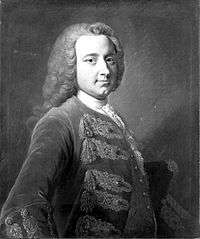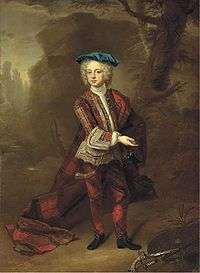Thomas Osborne, 4th Duke of Leeds


Thomas Osborne, 4th Duke of Leeds KG, PC, DL, FRS (6 November 1713 – 23 March 1789),[1] styled Earl of Danby from birth until 1729 and subsequently Marquess of Carmarthen until 1731, was a British peer, politician and judge.
Background
He was the older and only surviving son of Peregrine Osborne, 3rd Duke of Leeds and his first wife Elizabeth, youngest daughter of Robert Harley, 1st Earl of Oxford and Earl Mortimer.[2] Osborne was educated at Westminster School and then Christ Church, Oxford, where he matriculated in 1731.[3] In the same year, he succeeded his father as duke.[4] Osborne received a Doctorate of Civil Law in 1738[3] and became a Fellow of the Royal Society a year later.[5]
Career

Osborne became a Lord of the Bedchamber in 1748 and was appointed Justice in Eyre south of Trent in November of the same year.[6] In June 1749, he was made a Knight of the Order of the Garter and in 1756, resigning from his post as justice, was nominated Cofferer of the Household.[7] He was sworn of the Privy Council of Great Britain a year later and became Justice in Eyre north of Trent in 1761, an office he held until 1774.[6] Osborne was a Deputy Lieutenant of the West Riding of the County of Yorkshire.[8]
Family
On 26 June 1740, he married Lady Mary Godolphin, second daughter of Francis Godolphin, 2nd Earl of Godolphin and his wife Henrietta Godolphin (née Churchill), 2nd Duchess of Marlborough, and had by her three sons and a daughter.[2] Osborne died, aged 73 at St James's Square and was buried in the Osborne family chapel at All Hallows Church, Harthill, South Yorkshire.[3] He was succeeded in his titles by his third and only surviving son Francis.[2]
References
- ↑ "Leigh Rayment - Peerage". Retrieved 30 July 2009.
- 1 2 3 Debrett, John (1828). Debrett's Peerage of the United Kingdom of Great Britain and Ireland. vol. I (17th ed.). London: G. Woodfall. p. 19.
- 1 2 3 Cokayne, George Edward (1887). Complete Peerage of England, Scotland, Ireland, Great Britain and the United Kingdom. vol. V. London: George Bell & Sons. p. 37.
- ↑ "ThePeerage - Thomas Osborne, 4th Duke of Leeds". Retrieved 31 March 2007.
- ↑ "Royal Society - Library and Archive catalogue". Retrieved 30 July 2009.
- 1 2 Collins, Arthur (1812). Sir Egerton Brydges, ed. Collins's Peerage of England. vol. I. London: F. C. and J. Rivington et al. p. 260.
- ↑ Haydn, Joseph (1851). Beatson's Political Index modernised: The Book of Dignities; Containing Rolls of the Official Personages of the British Empire. London: Longman, Brown, Green and Longman's. p. 214.
- ↑ Doyle, James Edmund (1886). The Official Baronage of England. vol. II. London: Longmans, Green & Co. p. 329.
| Legal offices | ||
|---|---|---|
| Preceded by The Earl of Halifax |
Justice in Eyre south of Trent 1748 – 1756 |
Succeeded by The Lord Sandys |
| Preceded by The Lord Sandys |
Justice in Eyre north of Trent 1761 – 1774 |
Succeeded by The Lord Pelham of Stanmer |
| Political offices | ||
| Preceded by Sir George Lyttelton, Bt |
Cofferer of the Household 1756 – 1761 |
Succeeded by James Grenville |
| Peerage of England | ||
| Preceded by Peregrine Osborne |
Duke of Leeds 1731 – 1789 |
Succeeded by Francis Osborne |
| Baron Osborne (descended by acceleration) 1731 – 1776 | ||